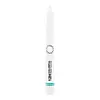Sephora Collection 12H Colorful Eyeshadow Stick & Liner Versus Laura Mercier Caviar Stick Eye Shadow Matte
What's inside
What's inside
 Key Ingredients
Key Ingredients

 Benefits
Benefits

 Concerns
Concerns

 Ingredients Side-by-side
Ingredients Side-by-side

Methyl Trimethicone
Skin ConditioningCI 77891
Cosmetic ColorantTrimethylsiloxysilicate
EmollientDicalcium Phosphate
AbrasiveSynthetic Wax
AbrasiveLauroyl Lysine
Skin ConditioningPolyethylene
AbrasiveSilica
AbrasiveCaprylyl Methicone
Skin ConditioningStearoxymethicone/Dimethicone Copolymer
EmollientStearyl Dimethicone
EmollientCopernicia Cerifera Wax
Octadecene
SolventDisteardimonium Hectorite
StabilisingPolyhydroxystearic Acid
EmulsifyingCaprylic/Capric Triglyceride
MaskingPentaerythrityl Tetra-Di-T-Butyl Hydroxyhydrocinnamate
AntioxidantPropylene Carbonate
SolventCrithmum Maritimum Extract
Skin ConditioningCI 42090
Cosmetic ColorantMica
Cosmetic ColorantMethyl Trimethicone, CI 77891, Trimethylsiloxysilicate, Dicalcium Phosphate, Synthetic Wax, Lauroyl Lysine, Polyethylene, Silica, Caprylyl Methicone, Stearoxymethicone/Dimethicone Copolymer, Stearyl Dimethicone, Copernicia Cerifera Wax, Octadecene, Disteardimonium Hectorite, Polyhydroxystearic Acid, Caprylic/Capric Triglyceride, Pentaerythrityl Tetra-Di-T-Butyl Hydroxyhydrocinnamate, Propylene Carbonate, Crithmum Maritimum Extract, CI 42090, Mica
Dimethicone
EmollientTrimethylsiloxysilicate
EmollientDicalcium Phosphate
AbrasiveLauroyl Lysine
Skin ConditioningSilica
AbrasivePolyethylene
AbrasiveSynthetic Wax
AbrasiveStearoxymethicone/Dimethicone Copolymer
EmollientMica
Cosmetic ColorantCaprylyl Methicone
Skin ConditioningDisteardimonium Hectorite
StabilisingRubus Idaeus Leaf Extract
Skin ConditioningRicinus Communis Seed Oil
MaskingSodium Hyaluronate
HumectantHydrogenated Castor Oil
EmollientCopernicia Cerifera Cera
EmollientPentaerythrityl Tetra-Di-T-Butyl Hydroxyhydrocinnamate
AntioxidantPolysilicone-11
Propylene Carbonate
SolventCaprylic/Capric Triglyceride
MaskingPolyhydroxystearic Acid
EmulsifyingCI 77491
Cosmetic ColorantCI 77492
Cosmetic ColorantCI 77499
Cosmetic ColorantCI 77891
Cosmetic ColorantCI 77007
Cosmetic ColorantDimethicone, Trimethylsiloxysilicate, Dicalcium Phosphate, Lauroyl Lysine, Silica, Polyethylene, Synthetic Wax, Stearoxymethicone/Dimethicone Copolymer, Mica, Caprylyl Methicone, Disteardimonium Hectorite, Rubus Idaeus Leaf Extract, Ricinus Communis Seed Oil, Sodium Hyaluronate, Hydrogenated Castor Oil, Copernicia Cerifera Cera, Pentaerythrityl Tetra-Di-T-Butyl Hydroxyhydrocinnamate, Polysilicone-11, Propylene Carbonate, Caprylic/Capric Triglyceride, Polyhydroxystearic Acid, CI 77491, CI 77492, CI 77499, CI 77891, CI 77007
Ingredients Explained
These ingredients are found in both products.
Ingredients higher up in an ingredient list are typically present in a larger amount.
This ingredient is an emollient, solvent, and texture enhancer. It is considered a skin-softener by helping the skin prevent moisture loss.
It helps thicken a product's formula and makes it easier to spread by dissolving clumping compounds.
Caprylic Triglyceride is made by combining glycerin with coconut oil, forming a clear liquid.
While there is an assumption Caprylic Triglyceride can clog pores due to it being derived from coconut oil, there is no research supporting this.
Learn more about Caprylic/Capric TriglycerideCaprylyl Methicone is a type of silicone.
It helps soften and soothe the skin by creating a thin film on top. This film helps trap moisture, keeping your skin hydrated.
Ci 77891 is a white pigment from Titanium dioxide. It is naturally found in minerals such as rutile and ilmenite.
It's main function is to add a white color to cosmetics. It can also be mixed with other colors to create different shades.
Ci 77891 is commonly found in sunscreens due to its ability to block UV rays.
Learn more about CI 77891Dicalcium Phosphate is an exfoliant.
Disteardimonium Hectorite comes from the clay mineral named hectorite. It is used to add thickness to a product.
It can also help stabilize a product by helping to disperse other ingredients.
Hectorite is a rare, white clay mineral.
Learn more about Disteardimonium HectoriteThis ingredient comes from a fatty acid (lauric acid) and amino acid (lysine). It is used to add a silky feel to cosmetics.
According to a manufacturer, its fatty acid base leaves a silky feeling on the skin. It also has emollient properties because of this. Emollients help soften skin by preventing water from evaporating.
Lauroyl lysine is barely soluble in water.
Learn more about Lauroyl LysineMica is a naturally occurring mineral used to add shimmer and color in cosmetics. It can also help improve the texture of a product or give it an opaque, white/silver color.
Serecite is the name for very fine but ragged grains of mica.
This ingredient is often coated with metal oxides like titanium dioxide. Trace amounts of heavy metals may be found in mica, but these metals are not harmful in our personal products.
Mica has been used since prehistoric times throughout the world. Ancient Egyptian, Indian, Greek, Roman, Aztec, and Chinese civilizations have used mica.
Learn more about MicaPentaerythrityl Tetra-Di-T-Butyl Hydroxyhydrocinnamate (long name, huh?) is a synthetic antioxidant.
It is used to help stabilize other antioxidants or prevent the color from changing in a product.
As an antioxidant, it helps fight free-radical molecules. Free-radical molecules are capable of damaging our cells and other genetic material. Thus, antioxidants may reduce the signs of aging.
This ingredient is oil-soluble.
Learn more about Pentaerythrityl Tetra-Di-T-Butyl HydroxyhydrocinnamatePolyethylene is a synthetic ingredient that helps the skin retain moisture. It is a polymer.
It is also typically used within product formulations to help bind solid ingredients together and thicken oil-based ingredients. When added to balms and emulsions, it helps increase the melting point temperature.
Polyhydroxystearic Acid is a soft wax made from castor oil.
It is is a texture thickener, emulsifier, and film-former. Emulsifiers prevent ingredients from separating, such as oils and waters.
Polyhydroxystearic Acid may not be fungal acne safe.
Learn more about Polyhydroxystearic AcidThis ingredient is a solvent. It helps dissolve active ingredients and alter the texture of products.
Propylene Carbonate is commonly used in makeup and with clay, such as montmorillonite or bentonite.
Studies show this ingredient to be safe for cosmetics. When it is undiluted, it can cause skin irritation. (It is always diluted in skincare and makeup). This ingredient is water-soluble.
Propylene Carbonate is created from propylene glycol and carbonic acid.
Learn more about Propylene CarbonateSilica, also known as silicon dioxide, is a naturally occurring mineral. It is used as a fine, spherical, and porous powder in cosmetics.
Though it has exfoliant properties, the function of silica varies depending on the product.
The unique structure of silica enhances the spreadability and adds smoothness, making it a great texture enhancer.
It is also used as an active carrier, emulsifier, and mattifier due to its ability to absorb excess oil.
In some products, tiny microneedles called spicules are made from silica or hydrolyzed sponge. When you rub them in, they lightly polish away dead skin layers and enhance the penetration of active ingredients.
Learn more about SilicaStearoxymethicone/Dimethicone Copolymer is a type of silicone.
Synthetic Wax is created from fossil fuels such as natural gas. It is used to enhance texture, adjust pH, and as an occlusive.
It may also be used as an abrasive ingredient to exfoliate the skin.
Synthetic Wax may not be fungal acne safe.
Learn more about Synthetic WaxThis silicone is an emollient. Emollients create a thin film on the skin to prevent moisture from escaping.
It is not soluble in water and helps increase water-resistance in products.
According to a manufacturer, it can blend seamlessly with silicone oils, such as Cyclopentasiloxane.
Learn more about Trimethylsiloxysilicate